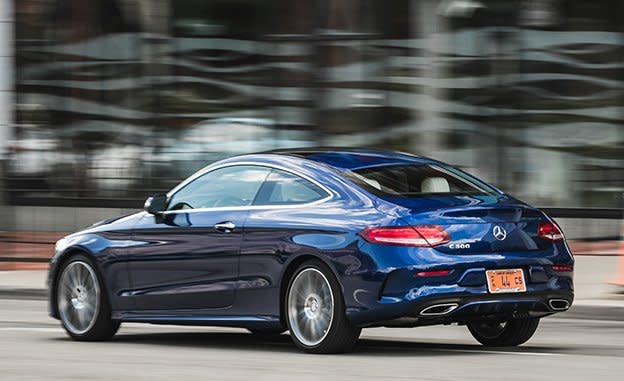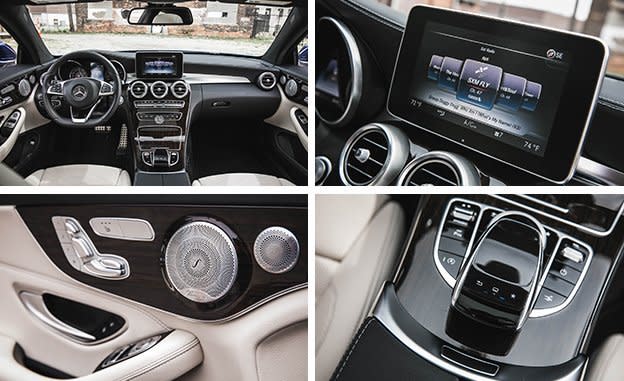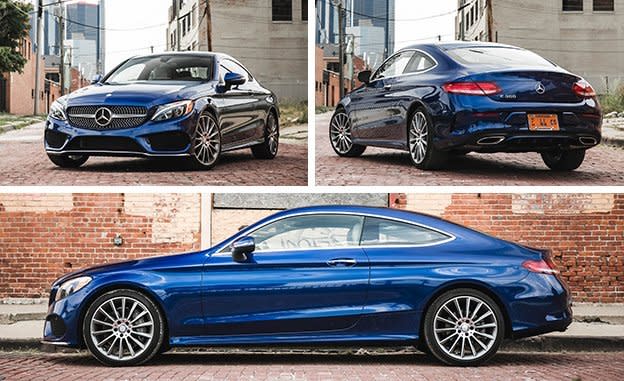2017 Mercedes-Benz C300 Coupe

Why bother with a two-door car? They’re far less practical than their four-door counterparts, rear-seat access generally requires the flexibility of a gymnast, and their long doors are a pain in tight parking lots. It used to be that a two-door was cheaper than the equivalent four-door, but now they often cost more. They may be fractionally lighter, but that’s not guaranteed. The only real reason to choose a coupe is for looks.
Its Looks Could Thrill
In previous generations of the Mercedes-Benz C-class, however, the model labeled a coupe was more of a staid two-door sedan. The new one makes a more dramatic break from the four-door model: Its roofline is 1.5 inches lower and tapers quickly to the rounded tail. The taillamps are horizontal rather than vertical, just as they are on the S-class coupe, and the license plate moves down to the bumper, leaving a cleaner trunklid. On the sedan, the body-side crease dips as it travels front to rear, while it remains straight on the coupe, and the whole car sits lower on its wheels. Turning up the style wattage out front is a larger, lower grille that’s a constellation of floating chrome stars, another design element borrowed from the range-topping two-door.

The visual drama continues inside. The dash is the same as that of the C-class sedan—in fact, much of the interior design is shared. And, really, why shouldn’t it be? After all, we’ve crowned the C-class cabin The Best Car Interior Under $60,000. Here, too, exquisite materials and liberally applied brightwork make this cabin a visual and tactile delight.
But “best” is not to say “best equipped.” You’ll pay extra for leather ($1620 for gorgeous porcelain-colored hides, in the case of our test car), wood trim ($375), heated seats ($580), a backup camera ($460), and navigation (the last item as part of the $4500 Premium 2 Package). At least an oversize sunroof is standard—as it is (coincidentally?) in the BMW 4-series—the better to illuminate the cozy cabin.
And it is cozy. The inviting front thrones with integral headrests are as comfortable as they look, but the seating position is lower than in the sedan. Behind are two rear seats, but it’s a feat getting back there, and their unfortunate occupants quickly come to understand the sacrifices made for that sloping, tapered roofline. Similarly, the trunk, while reasonably sized, finds its opening pinched by the fast-sloping, rounded rear glass.
Ah, but those are sedan concerns. What you really want to know is whether the C-class coupe is as artful in motion as it is standing still. Not quite.
Beauty in Motion
In many respects, the C-class coupe displays newfound athleticism. It comes standard with a firmer suspension tune than the sedan as well as quicker steering—both aspects enhanced in our test car by the optional 19-inch wheels with high-performance summer tires ($500). That aggressive, Pirelli P Zero rubber held on tight at the skidpad, where we measured 0.91 g of lateral grip; the tires also contributed to the C300 stopping from 70 mph in just 157 feet. Those skidpad and brake-test figures best those of the Lexus RC200t and the BMW 428i, nudge right up against the numbers posted by the Cadillac ATS coupe, and fall just shy of those recorded by our last Audi A5 (also on P Zeros).

This new C-class corners confidently and is dynamically sharper than its predecessors—but when it came time to put the right pedal down, the C300 revealed itself to be less of a jock. Our rear-drive C300 (4MATIC all-wheel drive is a $2000 upcharge) needed 6.2 seconds to sprint to 60 mph, and it ran the quarter-mile in 14.7 seconds at 94 mph. That’s well off the pace of the speedy BMW 428i’s 5.3 seconds and 14.1 at 99 mph with rear-wheel drive and an automatic. It also trails the lithe and lively ATS (a rear-drive, six-speed manual example), which hustled to 60 in 5.7 and through the quarter in 14.1 at 101 mph. The C300 nearly ties the A5 Quattro automatic and looks quick only against the lackadaisical Lexus (also all-wheel drive and with an auto gearbox).
Tyranny of the 2.0-Liter Turbo Four
Like every one of its competitors, the C300 has a 2.0-liter, direct-injected, turbocharged four-cylinder. The Benz’s engine’s 241 horsepower and 273 lb-ft is about mid-pack in this group; it doesn’t feel particularly rev-happy or energetic, although the seven-speed automatic—a placeholder until the new nine-speed arrives next year—is a willing partner. Is it shouldering a terrible burden? Not really. At 3632 pounds, the C300 is heavier than the flyweight ATS (3479) and the 428i (3529) but lighter than the A5 (3713) and the RC200t (3838).
Direct-injected turbo four-bangers may be spreading like kudzu throughout the luxury-car class—and virtually everywhere else in the auto biz—but they rarely sound great, and that’s the case here, too. The rattly engine note at idle is most objectionable. That being the case, you may as well let the auto stop/start feature do its thing, particularly since its restarts are fairly smooth. Rev the little 2.0-liter, and its tune changes but still sounds a tad agricultural—evidently, it’s the price you pay for efficiency. EPA ratings are 23 mpg city and 30 mpg on the highway.

Mercedes shoppers smitten with this shape but wanting a little more oomph and a little more soul in the powertrain department are well advised to check out the upcoming Mercedes-AMG C43 version, with its 3.0-liter twin-turbocharged V-6 that’s good for 362 horsepower. (Those wanting a shapely coupe that’s also a fire-breathing monster probably already have their eye on the Mercedes-AMG C63, which bristles with 503 horsepower from its 4.0-liter twin-turbo V-8.)
Stepping up to the sportier, AMG-tuned C43 likely wouldn’t bring a diminution in ride quality, mostly because the C300 is pretty stiff-riding already. Impacts are sharp—which is not terribly surprising given our test car’s ultra-low-profile, run-flat tires (225/40-19 front, 255/35-19 rear). Choosing the standard 18-inch wheels, or opting for the available air-spring suspension, might help.
Overall, the C300 does drive better than any non-AMG C-class coupe before, but that’s still not why you’d buy it. You’d buy one for the way it looks—inside and out. And if its aesthetics demand too much of a sacrifice, there’s always the four-door.
Specifications >
VEHICLE TYPE: front-engine, rear-wheel-drive, 4-passenger, 2-door coupe
PRICE AS TESTED: $54,685 (base price: $43,575)
ENGINE TYPE: turbocharged and intercooled DOHC 16-valve I-4, aluminum block and head, direct fuel injection
Displacement: 122 cu in, 1991 cc
Power: 241 hp @ 5500 rpm
Torque: 273 lb-ft @ 1300 rpm
TRANSMISSION: 7-speed automatic with manual shifting mode
DIMENSIONS:
Wheelbase: 111.8 in
Length: 184.5 in
Width: 71.3 in Height: 55.3 in
Passenger volume: 86 cu ft
Cargo volume: 11 cu ft
Curb weight: 3632 lb
C/D TEST RESULTS:
Zero to 60 mph: 6.2 sec
Zero to 100 mph: 16.2 sec
Zero to 130 mph: 32.7 sec
Rolling start, 5–60 mph: 7.1 sec
Top gear, 30–50 mph: 3.8 sec
Top gear, 50–70 mph: 4.7 sec
Standing ¼-mile: 14.7 sec @ 95 mph
Top speed (governor limited): 130 mph
Braking, 70–0 mph: 157 ft
Roadholding, 300-ft-dia skidpad: 0.91 g
FUEL ECONOMY:
EPA city/highway driving: 23/30 mpg
C/D observed: 26 mpg

 Yahoo Autos
Yahoo Autos 